

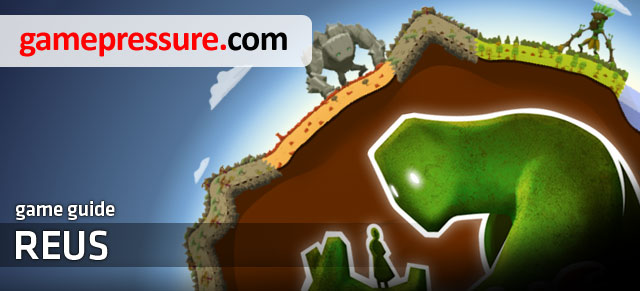
This guide includes:
Reus is a game that, only seems similar to the others where you play God. In here, you have got the entire planet under your control and there is clothing that could possibly stands in your way.. Unless your subjects rebel against you, that is.
Black - Screenshot commentary and information that it is worthwhile to pay attention to
Brown - Civilizations and their buildings
Blue - Powers of the Giants
Green - The contents of the planet segments
Orange - Resources: food, wealth, science, nature, Danger and awe.
Dawid "Kthaara" Zgud ()
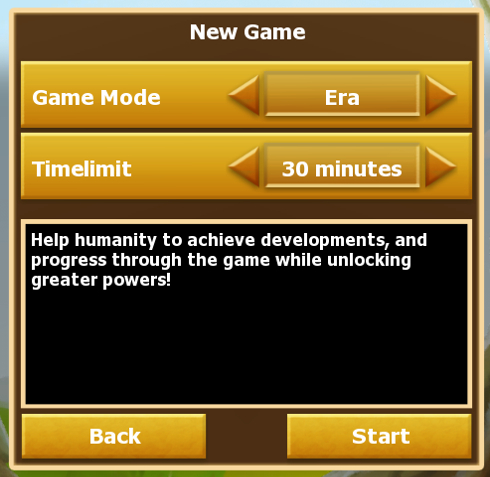
There are three game modes: Beginning, Era and Freeplay.
This mode is simply a tutorial. It teaches you, step by step, how to start your adventure with the Giants and the denizens of the initially-dry planet.
It is divided into three eras- the first one, the second one and the third one. In each of these parts, you learn about more elaborate aspects of the gameplay, and shows how to go on at the time of crisis.
This is the main mode. You can decide on how long you want the game to take. You ca chose 30, 60 or 120 minutes. At first, there is only the 30-minute option available. The access to the remaining ones is blocked and, to unlock it, you need to have gotten a defined amount of achievements.
For meeting certain premises and requirements (e.g. raising a village with 100 prosperity points) you receive a bonus of a point for unlocking the next mode and, in most cases you unlock another element of the game - a plant, an animal or a mineral, which become available in the next game, thanks to the transmutation tools.
This mode is no different from the Era mode but, you do not win achievements here, and the time is unlimited.
The planet is the "main character" in the game. The Giants, that you control, are only instrumental to your actions, whose aim is to support life developing on the ground.
An important aspect to the flourishing life is the terrain, where people will set up their villages. There are upsides and downsides to each terrain type. Additionally, there is a separate set of plants, animals and minerals to each.
Terrain type
Description

Forest is a pleasant place where nomads settle. Its animals and plants yield a lot of food and their symbiosis also hinges on the increase in the amount of food.
The Forest Giant: Plant (Food) - Berries.
The Ocean Giant: Animal (Food) - Chicken.
The Swamp Giant: animal (Resource) - Stoat; Plant (science) - Dandelion.
The Rock Giant: Mineral (resource) - Agate, Mineral (science) - Stone.

Desert in not too hospitable a terrain type when it comes to plants. Still, animals work well here. The natural choice is the development of resources -you cannot acquire too much food from the animals.
The Forest Giant : Plant (food) - withered shrub.
The Ocean Giant: Animal (food) - Kangaroo rats.
The Swamp Giant: Animal (wealth) - Desert Tortoise; Plant (science) - withered shrub.
The Rock Giant: Mineral (resource) - Quartz, Mineral (science) - stone.

Swamps is not the best terrain type to start the production of food, although some symbioses provide quite a few of it. The actual it is a good terrain for growing herbs - their symbiosis provides a lot of science.
The Forest Giant : Plant (food) - Elder.
The Ocean Giant: Animal (food) - Frogs.
The Swamp Giant: An (resource) Animal- Poison Dart Frogs; Plant (science) - Mint.
The Rock Giant: Mineral (resource) - Agate, Mineral (science) - Marble.
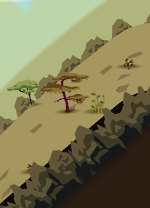
Mountain Ranges are entirely different ecosystems. They include animals, plants and symbioses different from what you have seen so far. Villages are never built on the mountainsides. Travelers fear that it may be The Rock Giant.
The Forest Giant : Plant (food) - Kumquat.
The Ocean Giant: Animal (food) - Martens.
The Swamp Giant: Animal (resource) - Monal (resembles a peacock); Plant (science) - Ginger.
The Rock Giant: Mineral (resource) - Agate, Mineral (science) - Stone.

Oceans, as such, are not useful for humans although, they may house resource, or food-providing animals.
The Forest Giant : Plant (food) - Nothing.
The Ocean Giant: Animal (food) - Fish.
The Swamp Giant: Animal (resource) - Clownfish; Plant (science) - nothing.
The Rock Giant: Mineral (resource) - nothing, Mineral (science) - nothing.

Wasteland- it is the terrain form that the planet is covered with, after you start a game. You cannot plant any useful resource there. When neighboring the Ocean it turns into n irrigated wasteland that can develop a forest or swamps.
Every game is played on the surface of the planet that consists of segments. On the segments, after you create an ocean, forest, desert or swamp, the Giants may also add various resources, like plants, animals and minerals.
There are three levels to each resource that you can put on an individual segment. These levels, can be unlocked with a special combination of ambassadors on the shoulders of individual giants.
For example: The Forest Giant can add fruit-bearing plants. In the forest, the berries are this kind of plants. If you order the giant to lay berries, when there is no ambassador on its shoulders, the statistics for the berries are as follows:
Berries: 5 food, 1 nature. Symbiosis: +10 food when there is a nearby strawberry, apple tree or dandelion.
When you unlock level two, with two ambassadors: one forest and any other, then you will be able to plant better berries:
Bigger berries: 10 food, 1 nature. Symbiosis: +20 food while next to strawberry, apple tree or dandelion.
If you follow this logic, and equip the giant with two forest ambassadors and two ambassadors of any kind you can unlock level three of the potential for the fruit plants, which will allow you to plant even better berries in the forest:
Super-berries: 20 food, 2 nature. Symbiosis: +40 food if it is next to a strawberry, apple tree or dandelion.
This way, a single segment can provide you with a lot of food which adds its pool to the development of the village.
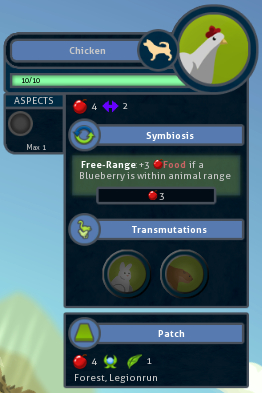 Symbiosis
SymbiosisThis term defines a power that allows you to convert a small cluster of shrubs into a powerful food factory, or a small meadow overgrown with mint into every scientist's heaven.
Each element that you plant - Mineral, Animal or a Plant has in its description field, a field named Symbiosis. This provides you with a description of bonuses, and gives you the requirements that you need to meet in order to get the bonus.
Example: Kangaroo rats are desert animals that provide food. They provide you with one point per field, within two fields of the nest. Their symbiosis consists in their preference to hide in mines. If you order the Rock Giant to plant a mineral within their reach, the food provided by the Kangaroo rats will increase threefold. Below, you can find examples of symbioses for in each of the ecosystems.
Sometimes, certain conditions, generated by the village, need to occur for symbiosis to occur. In most cases, minerals have such symbiosis. It hinges on the requirement that, for symbiosis to occur, the village needs to use, at least, five science or resources points.
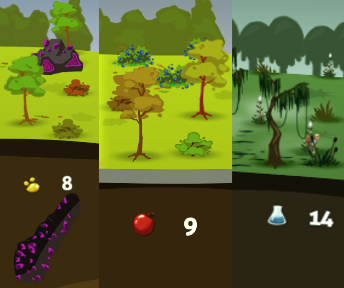 Three main resources
Three main resourcesIn the game, there are four natural resources: food, wealth, science, awe, Danger and nature.
Food - is a resource provided to you by plants and Animals. Forest villages ,most frequently, base their projects on it. The basic plants: berries, kumquats, elder, agave (after being transmuted). The basic Animals: chicken, martens, frogs, Kangaroo rats, mackerels.
Examples of symbioses:
Wealth - this resource is, most frequently, provided by minerals and exotic animals. Desert villages base their projects on it. The basic Animals: clownfish, stoat, Poison Dart Frog, desert tortoise, monal. Basic minerals: quartz, agate.
Examples of symbioses:
Science - both plants and minerals provide it. Swamp villages base their projects on it. Basic plants: mint, ginger, dandelion. Basic Minerals: stone, marble.
Examples of symbioses:
Awe - is a "resource", which causes drop in greed of the denizens by increasing the between the resource "in use" and the available one, which needs to occur to spur greed. At the beginning of the game, it can be added to the segments by using aspects.
Danger- this element allows you to influence the behavior of the villagers. If a village is greedy in the war between them and the neighboring villages is pending, you can prevent it by creating segments with animals that Endanger the village. That is when the villagers will be too consumed with battling the Danger, their greed will stop growing and they will lose their interest in fighting their neighbors. Examples of Animals - wolves, rattlesnakes, stoats, martens.
There are three Danger levels for a village- low, moderate and high. When the Danger level remains no higher than moderate, the villagers feel safe- this does not influence greed. When they are under moderate Danger, the villagers will have to put up a fight against the hostile environment, which supplants the increase of greed. Once the Danger is high, the villagers, will either destroy the endangering segment to return to the moderate Danger, or die out.
Nature- this resource is connected with plants which you place on the segments. Some elements have their symbiosis depend on the nature (like the Onyx (resulting from the transmutation of Salt or Topaz) reaches 1.5 Resources for each nature point on its segment).
The Giants are your helpers - thanks to them, you can transform the planet's surface in such a way, as to make it capable of supporting life. Each giant has different abilities, some require taking an ambassador from a given village on the shoulders, to be unlocked.
There are levels to the giants' abilities- to unlock the higher level of a given ability, the giant needs to carry the right combination of ambassadors on its shoulders.
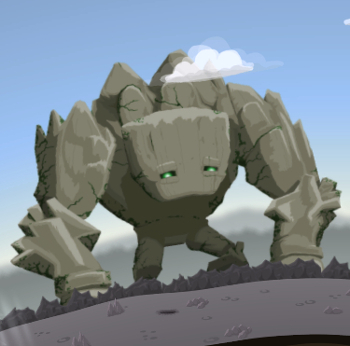 The Rock Giant
The Rock GiantMountain - The Rock Giant can create mountains. If it creates one on a dry land (far from the ocean) around, (~ 10 segments) , this will create a desert. Mountains can also be created to make an ocean disappear.
Precious minerals - The ability to create deposits of minerals that give wealth, like Agate or Quartz. The kind of mineral depends on what kind of terrain you put it on. .
Advanced Minerals- You can lay down deposits of minerals that build up on science e.g.. Stone.
Exotic - adds the aspect of exoticism to an Animal, which adds, or increases the wealth. It can be unlocked with a forest ambassador.
Noble - adds the aspect of nobility to a mineral, which increases, or endows it with wealth. It can be unlocked with a desert ambassador.
Seismic - adds the seismic aspect to a Mineral, which increases science and awe. It can be ensured with a swamp ambassador.
Earthquake - causes tremendous damage. A well-developed village can be destroyed with two earthquakes.
Ability levels:
Level
Precious min.
Adv. min.
Exotic
Noble
Seismic
Earthquake
I
-
-
F
D
S
-
II
D, A
S, A
L, L
D, D
S, S
F
III
D, D, A, A
S, D, A, A
F, F, A, A
D, D, D, A
S, S, A, A
F, D, A, A
Legend: F- forest, D -desert, S - swamp, A - Any
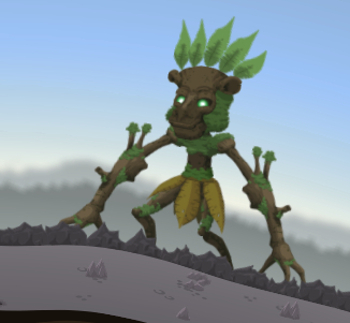 The Forest Giant
The Forest GiantForest - Within the radius of 10 cells of the giant in the wet lands you can create a forest. It can be planted only near the ocean.
Fruit plant - it creates a fruit plant that provides food. There is a different plant for each ecosystem. (berries, withered shrubs, elder, kumquats).
Leaf - Adds science and nature to a plant. It comes unlocked by default and you need no ambassador for that.
Fruit) - a plant with this aspect, provides more food. To unlock it, you are going to need a Forest ambassador.
Hunt - this works on animals by adding food and Danger to it. To unlock it, you are going to need a Desert ambassador.
Fertility - causes temporary increase in the operation of aspects in a given segment.
Migrate - enables toy to transfer an entire segment along with its resources, which is preserved this way. Normally, to build a segment, you need to perform several actions and employ several giants. To unlock it, you are going to need a swamp ambassador.
Ability levels:
Level
Fruit plant
Deciduous
Fruit
hunt
fertility
migration
I
-
-
F
D
-
S
II
F, A
S,A
F, F
D, D
D, A
S, S,
III
F, F, A, A
S, F, A, A
F, F,F, A
D, D, A, A,
D, F, A, A
S, S, A
Legend: F- forest, D -desert, S - swamp, A - Any
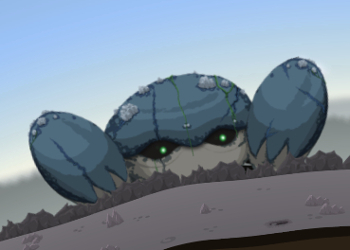 The Ocean Giant
The Ocean GiantOcean - creates an ocean of the width of around 10 segments in a specified area. On both sides, it creates a wetland that makes it possible to plant a forest or swamp.
Domestic animals - on a specified segment an animal nest is created, which increases food efficiency of the neighboring segments. For each ecosystem, there are different animals available (mackerels, chicken, Kangaroo rats, frogs martens).
Growth - the designated plant receives additional points to nature and food. It is available by default and does not require an ambassador.
Herd - improves on the animal segment and increases its food. Requires a swamp ambassador to unlock
Crystal - thanks to this improvement, mineral is going to yield more wealth. Requires a Forest ambassador to unlock.
Aurora - A spell that allows you to heal the giant. Additionally, it increases its agility and speed.
Monsoon - the giant summons a monsoon in a given area, which works like a mass fertility aspect. Requires a desert Ambassador to unlock.
Ability Levels:
Level
Domestic animals
Growth
Herd
Crystal
Aurora
Monsoon
I
-
-
S
F
-
D
II
S, A
D, D
S, S
F, F
F, A
D, A
III
S, A, A, A
D, D, D, A
S, S, S, A
F, F, F, A
F, A ,A
D, A, A, A
Legend: F- forest, D -desert, S - swamp, A - Any
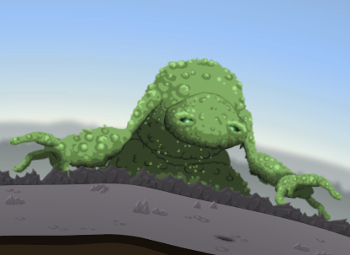 The Swamp Giant
The Swamp GiantSwamp - Within the radius of around 15 segments of the giant, this creates a swamp, unless the ground is not wet enough.
Herbs - creates plants that increase science in a specified area. For each ecosystem, there is a different kind (mint, ginger, dandelion, withered shrubs)
Exotic animals - summons animals that give wealth. Each area has its own (clownfish, stoat, Poison Dart Frog, desert turtle, monal).
Toxic - improves a plant by increasing its toxicity level, thus making it more valuable for science. Requires a Swamp Ambassador to unlock.
Predator - improves on the animal segment, which makes it more valuable for wealth and increases its aggressiveness, which in turn increases Danger. Requires a Desert ambassador to unlock.
Reaction - improves minerals and increases their value for science. Requires a Forest ambassador to unlock.
Muck Bomb - Inflicts damage over time (7x7sec). The Muck bomb damage is restricted to humans only and does not damage buildings.
Ability Levels:
Level
Herb
E. animal.
Toxic
Predator
Reaction
Muck bomb
I
-
-
S
D
F
-
II
F, A
D, A
S, S
D, D
F, F
S, A
III
F, S, A, A
D, S ,A ,A
S, S, S, A
D, D, A, A
F, F, A, A
S, S, A, A
Legend: F- forest, D -desert, S - swamp, A - Any
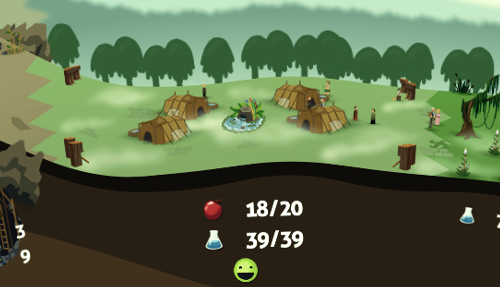
Since "your character" is the planet and Giants are your helpers, you need to make the surface cover in lush life. You can achieve that only by means of terraforming of dry lands with the help from the Giants and by reinforcing that life.
Villages are only created on welcoming lands (i.e. in the forest, in the desert or in the swamps) when there is a resource available (e.g. food). Then, out of nowhere, along comes a wanderer, who starts a village.
There are three kinds of villages: forest, desert and swamp. Each type has different characteristics, although, by providing excess resources of a given kind you can partially influence the choice of projects. The forest village prefers projects that carry a bonus to food, Desser villages prefers gold, so their projects are about increasing wealth, and Swap villages like taking on the projects connected with the development of science.
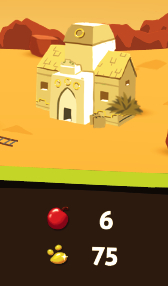 Desert Village project
Desert Village projectProjects are special buildings built somewhere at the verge of the village. When a village starts a project (which usually occurs a dozen or so seconds after the village is started) you will receive a note informing you that "village X started Project Y" and they require your help. Helping consists in meeting the project requirements in a specified frame of time.
Usually, meeting the project requirements consists in increasing the available resources for a given village although, these may be requests that are occasionally difficult to fulfill. For example, destroying a nearby village requires a second thought.
There are three levels of projects - basic, improved and grand. Obviously, the higher the level, the more difficult it is to meet the requirements.
A project, gives a village the opportunity to specialize- a specific bonus, it for example gives 15 wealth per each mineral within the village's boundaries. Specialization starts to work right after the building process starts. The higher the project level, the more bonuses it provides. Grand projects yield three bonuses.
Usually, the finished project provides you with a certain bonus: an ambassador for the village. There are three kinds of villages and just as many ambassadors. Ambassadors are special units that can unlock the abilities of the Giants.
The number of appearing ambassadors is limited: if the number of ambassadors on the giants' shoulders is not larger than 6, there will be new ambassadors coming. If the number is greater, the new ambassadors will be coming after the improved and the advanced projects are completed. The next threshold is 10 ambassadors. They can be provided by the advanced projects then. When the number of ambassadors reaches 14, no project will yield an ambassador.
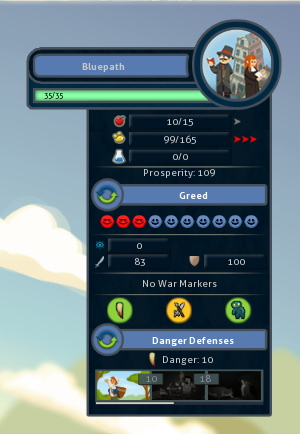
The phenomenon of greed, is a disadvantageous one and it grows when there is a large amount of resources within a village's boundaries, which it wants to use up quickly. The avarice is symbolized by red arrowheads that appear next to a given resource, shown in the above screenshot. The greater the difference between the "owned" and the possible amounts the greater the income and greed. The longer it lasts, the more red faces appear on the Greed bar.
As soon as it reaches a half of its length, the village starts waging wars against its neighbors. Still, it is reversible. Every lost battle decreases the bar by one. But, when it reaches its highest level, the villagers may turn against the Giants and you will have no other choice but re-convert the village and the villagers in a more direct way. You can achieve it by attacking the village which will cause the decrease in the greed bar.
The greediness of the villagers can be controlled directly by improving segments and endowing them with Danger or awe.
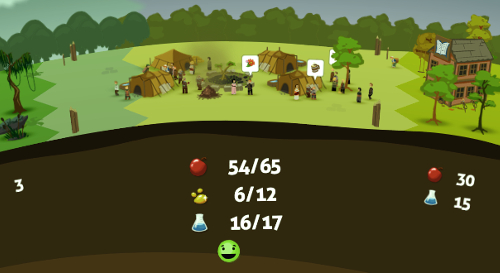
Forest villages are created by nomads in the forests, most frequently next to the berries. They most often build projects concerned with amassing food.
The value that grows fastest in the forest is food, because the plants and animals that you put here have more of it than any other aspect. It is a good idea, though, to control the kind of projects built by the villagers - a project can cause a drastic increase in a given resource, which makes for greed...
Forest Ambassador unlocks the following bonuses:
The Rock Giant - Exotic- increases the amount of wealth in animals.
The Forest Giant -Fruit- increases the food in a plant.
The Ocean Giant - Crystal - increases the wealth in a mineral.
The Swamp Giant -Reaction- adds science in a mineral.
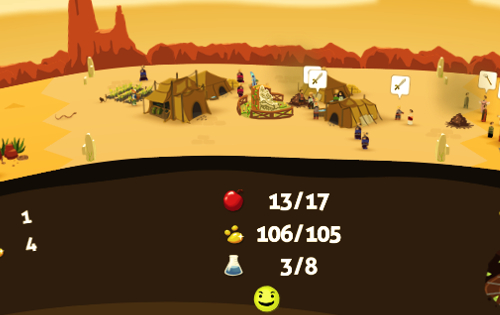
This kind of villages, as the name itself suggests, are started in deserts, usually near a mountain. They most frequently build projects that involve increasing wealth.
The wealth factor grows fastest in these villages because there are no basic plants growing in the desert. The fast increase in the wealth of the villagers, may increase the greed factor and, the villagers will want to wage war as a result.
This ambassador gives to the Giants the following abilities:
The Rock Giant -Noble- adds wealth to a mineral.
The Forest Giant -Hunt- adds food and Danger to an animal.
The Ocean Giant - Monsoon - ability that initiates the mass spell of fertility.
The Swamp Giant -Predator- adds wealth and Danger to an animal.
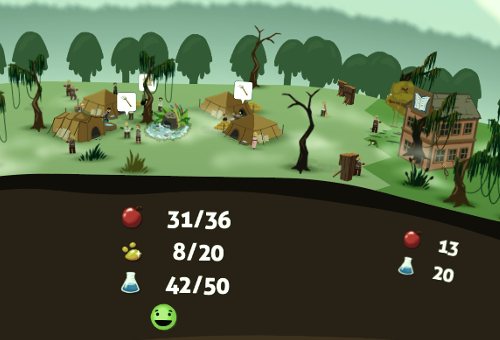
The swamp villages due to the insufficiency of sources of wealth and food concentrate on amassing science. Most often, they start projects that require increasing the available science factor.
In the swamp the most usual plants to be found are herbs, that increase science. Combined with the technology-literate villagers and their projects, this may lead to a growth of that resource and, to excessive greed, as a result.
This ambassador gives the following bonuses to the giants:
The Rock Giant -seismic- adds science and awe to minerals science and respect.
The Forest Giant - migration- allows you to transfer the ready-made segments with their resources
The Ocean Giant -herd - improves animal and adds food to it.
The Swamp Giant -toxic- increases the value of plants for science.


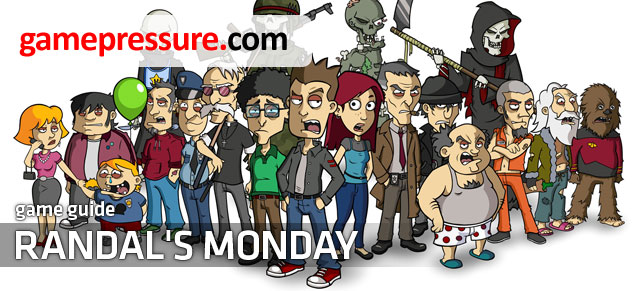

 Resident Evil 6 Game Guide & Walkthrough
Resident Evil 6 Game Guide & Walkthrough Remember Me Game Guide & Walkthrough
Remember Me Game Guide & Walkthrough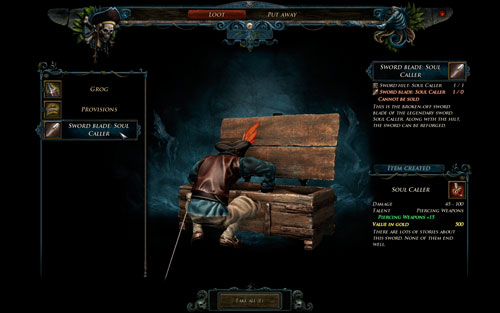 Risen 2: Dark Waters Game Guide & Walkthrough
Risen 2: Dark Waters Game Guide & Walkthrough Resident Evil 5 Game Guide & Walkthrough
Resident Evil 5 Game Guide & Walkthrough Risen 3: Titan Lords Game Guide & Walkthrough
Risen 3: Titan Lords Game Guide & Walkthrough